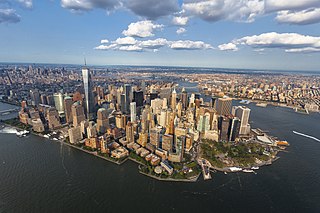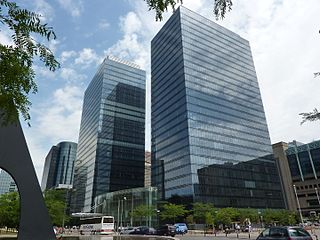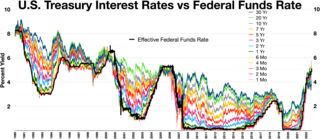Related Research Articles

The economy of Israel is a highly developed free-market economy. The prosperity of Israel's advanced economy allows the country to have a sophisticated welfare state, a powerful modern military said to possess a nuclear-weapons capability with a full nuclear triad, modern infrastructure rivaling many Western countries, and a high-technology sector competitively on par with Silicon Valley. It has the second-largest number of startup companies in the world after the United States, and the third-largest number of NASDAQ-listed companies after the U.S. and China. American companies, such as Intel, Microsoft, and Apple, built their first overseas research and development facilities in Israel. More than 400 high-tech multi-national corporations, such as IBM, Google, Hewlett-Packard, Cisco Systems, Facebook and Motorola have opened R&D centers throughout the country.
In economics, a recession is a business cycle contraction that occurs when there is a general decline in economic activity. Recessions generally occur when there is a widespread drop in spending. This may be triggered by various events, such as a financial crisis, an external trade shock, an adverse supply shock, the bursting of an economic bubble, or a large-scale anthropogenic or natural disaster.

The economy of South Korea is a highly developed mixed economy. By nominal GDP, the economy was worth ₩2.24 quadrillion. It has the 4th largest economy in Asia and the 13th largest in the world. South Korea is notable for its rapid economic development from an underdeveloped nation to a developed, high-income country in a few generations. This economic growth has been described as the Miracle on the Han River, which has allowed it to join the OECD and the G20. It is included in the group of Next Eleven countries as having the potential to play a dominant role in the global economy by the middle of the 21st century. Among OECD members, South Korea has a highly efficient and strong social security system; social expenditure stood at roughly 15.5% of GDP. South Korea spends around 4.93% of GDP on advance research and development across various sectors of the economy.

The United States is a highly developed/advanced mixed economy. It is the world's largest economy by nominal GDP; it is also the second largest by purchasing power parity (PPP), behind China. It has the world's seventh highest per capita GDP (nominal) and the eighth highest per capita GDP (PPP) as of 2022. The U.S. accounted for 26% of the global economy in 2023 in nominal terms, and about 15.5% in PPP terms. The U.S. dollar is the currency of record most used in international transactions and is the world's reserve currency, backed by a large U.S. treasuries market, its role as the reference standard for the petrodollar system, and its linked eurodollar. Several countries use it as their official currency and in others it is the de facto currency. Since the end of World War II, the economy has achieved relatively steady growth, low unemployment and inflation, and rapid advances in technology.

The economy of Belgium is a highly developed, high-income, mixed economy.

Ofakim is a city in the Southern District of Israel, 20 kilometers (12.4 mi) west of Beersheba. It achieved municipal status in 1955. It has an area of 10,000 dunams. In 2022, it had a population of 35,506.
The early 1990s recession describes the period of economic downturn affecting much of the Western world in the early 1990s. The impacts of the recession contributed in part to the 1992 U.S. presidential election victory of Bill Clinton over incumbent president George H. W. Bush. The recession also included the resignation of Canadian prime minister Brian Mulroney, the reduction of active companies by 15% and unemployment up to nearly 20% in Finland, civil disturbances in the United Kingdom and the growth of discount stores in the United States and beyond.

Western Massachusetts, known colloquially as "western Mass," is a region in Massachusetts, one of the six U.S. states that make up the New England region of the United States. Western Massachusetts has diverse topography; 22 colleges and universities including UMass in Amherst, MA, with approximately 100,000 students; and such institutions as Tanglewood, the Springfield Armory, and Jacob's Pillow.

The early 2000s recession was a major decline in economic activity which mainly occurred in developed countries. The recession affected the European Union during 2000 and 2001 and the United States from March to November 2001. The UK, Canada and Australia avoided the recession, while Russia, a nation that did not experience prosperity during the 1990s, began to recover from it. Japan's 1990s recession continued.

The economy of the State of California is the largest in the United States, with a $3.89 trillion gross state product (GSP) as of 2023. It is the largest sub-national economy in the world. If California were a sovereign nation (2024), it would rank in terms of nominal GDP as the world's fifth largest economy, ahead of both India and the United Kingdom. Additionally, California's Silicon Valley is home to some of the world's most valuable technology companies, including Apple, Alphabet, and Nvidia. In total, 11 of the Fortune 100 companies and 53 of the Fortune 500 companies are headquartered in California.

The area that is now Massachusetts was colonized by English settlers in the early 17th century and became the Commonwealth of Massachusetts in the 18th century. Before that, it was inhabited by a variety of Native American tribes. Massachusetts is named after the Massachusett tribe that inhabited the area of present-day Greater Boston. The Pilgrim Fathers who sailed on the Mayflower established the first permanent settlement in 1620 at Plymouth Colony which set precedents but never grew large. A large-scale Puritan migration began in 1630 with the establishment of the Massachusetts Bay Colony, and that spawned the settlement of other New England colonies.
The recession of 1958, also known as the Eisenhower Recession, was a sharp worldwide economic downturn in 1958. The effect of the recession spread beyond the United States to Europe and Canada, causing many businesses to shut down. Officially, recessionary circumstances lasted from the middle of 1957 to April 1958. Though it is generally regarded as a moderate recession, it was the most significant recession during the post–World War II economic expansion between 1945 and 1973.

The early 1980s recession was a severe economic recession that affected much of the world between approximately the start of 1980 and 1982. It is widely considered to have been the most severe recession since World War II until the 2007–2008 financial crisis.
A business cluster is a geographic concentration of interconnected businesses, suppliers, and associated institutions in a particular field. Clusters are considered to increase the productivity with which companies can compete, nationally and globally. Accounting is a part of the business cluster. In urban studies, the term agglomeration is used. Clusters are also important aspects of strategic management.

This is a history of the economy of Italy. For more information on historical, cultural, demographic and sociological developments in Italy, see the chronological era articles in the template to the right. For more information on specific political and governmental regimes in Italy, see the Kingdom and Fascist regime articles.

The United States entered recession in January 1980 and returned to growth six months later in July 1980. Although recovery took hold, the unemployment rate remained unchanged and even grew through the start of a second recession in July 1981. The downturn ended 16 months later, in November 1982. The economy entered a strong recovery and experienced a lengthy expansion through 1990.
The early 1990s recession saw a period of economic downturn affect much of the world in the late 1980s and early 1990s. The economy of Australia suffered its worst recession since the Great Depression.

The economy of Greater Cleveland is diverse, but is based on healthcare, banking, finance, education, insurance, manufacturing, sports, and tech. The metropolitan area based in Cleveland is the 33rd largest in the country, and is home to over 2 million people.
The economic history of Switzerland shows the long-term transition from a poor rural economy to a world leader in finance with a very high standard of living. By 1900 it had become one of the wealthiest nations in Europe in terms of GDP.
Economic conditions in Silicon Valley have led to categorization of the region as an hourglass economy, a type of socioeconomic phenomenon that favors the disproportionate growth of the upper and lower classes with comparatively weak development of the middle class. This economy is typically a characteristic of highly developed nations and regions that experience a steady influx of capital, invest heavily in research and development, and have a high cost of living.
References
- ↑ Butterfield, Fox (May 1, 1988). "What you see is what you get". The New York Times . Retrieved April 14, 2012.
- ↑ Brown, Richard D; Tager, Jack (2000). Massachusetts: A Concise History . Amherst, MA: University of Massachusetts Press. p. 246. ISBN 978-1-55849-248-6.
- ↑ Brown & Tager 2000, p. 276.
- ↑ "Job Loss, Shrinking Revenues, and Grinding Decline in Springfield, Massachusetts: Is A Finance Control Board the Answer?" (PDF). University of Massachusetts Lowell. Archived from the original (PDF) on October 18, 2013. Retrieved June 10, 2015.
- ↑ "Technically, It's Still Route 128", route128history.org
- ↑ "Silicon Valley and Route 128: The Camelots of Economic Development". Journal of Applied Research in Economic Development . 10. C2ER. May 2013. Retrieved March 4, 2017.
- 1 2 Judge, Paul (August 13, 1997). "Boston's Route 128: Complementing Silicon Valley". Business Week . Archived from the original on March 25, 2016. Retrieved April 14, 2012.
- ↑ "Route 128: Birthplace of the Digital Age" Archived 2013-06-28 at archive.today , July 6, 2010, http://bizcloudnetwork.com Archived 2013-05-09 at archive.today
- ↑ Lentz, Philip (August 23, 1988). "Dukakis Had Help With `Massachusetts Miracle`". Chicago Tribune. Retrieved September 07, 2014.